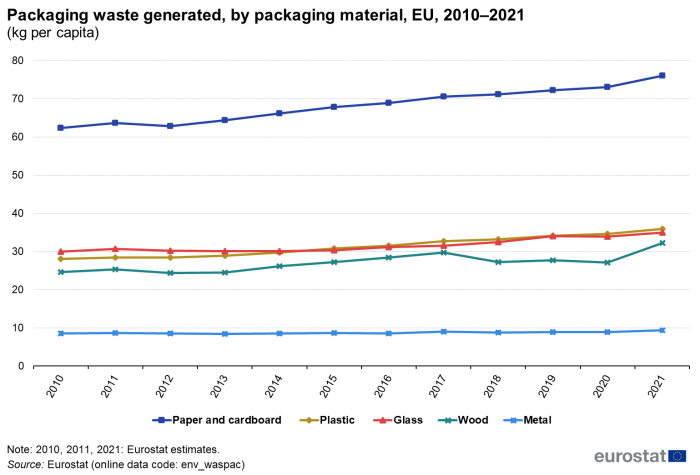How do you assess the current Eurostat statistics on packaging volumes in the European Union?
The Eurostat data (see diagrams below) are mass data. Important parameters on material efficiency, packaging sizes, the recyclability of individual packaging and substitution effects cannot be read from it. The data should therefore not be overinterpreted. The steadily increasing consumption of fibre-based packaging is striking. This is often recycled, which relativises its environmental impact. It is interesting to note the large differences between the countries and the fact that an increase can be seen in almost all countries.
In your opinion, what are the main factors contributing to the observed increase in packaging volumes?
The increase in the consumption of corrugated and cardboard packaging can be explained by the increase in online trade. In 2020 and 2021, the coronavirus pandemic has intensified online trade and thus the consumption of cardboard and corrugated cardboard packaging. It is interesting to note the jump in wood consumption from 2020 to 2021, which can certainly be explained by the increased consumption of wooden pallets due to increased trade.
Glass is experiencing a small renaissance as a packaging material. Packaging made of glass and wood weighs more than packaging made of plastic. This therefore has a somewhat greater impact on the total amount of waste. The consumption of plastic has also increased. The usual trends such as convenience, smaller pack sizes due to smaller households and the demand for hygienically packaged products are having an effect here. However, it could also be that easily recyclable packaging is somewhat heavier. A substitution of plastic with fibre-based materials can also be observed in some packaging.
How do you explain the significant differences in packaging volumes between different EU countries, such as the difference between Croatia and Ireland or Germany?
Ireland and Germany are not far apart. For 2021, packaging consumption is 237 kg per person per year in Germany and 246 kg in Ireland. The figure for Croatia is 74! The data from Eurostat does not allow me to make a good analysis here. It is unclear to me whether the data basis is the same everywhere. However, it can be assumed that a lower gross domestic product per person and a larger average household size in Croatia correlate with less packaging consumption. The trends are therefore plausible.
How has the volume of different packaging materials changed in recent years?
The industry's great efforts to offer recyclable packaging have led to material substitution. Many, but not all, types of packaging have become somewhat heavier, but more recyclable.
What is much more interesting for me is that, despite the many discussions about "unpackaged" and reusable packaging, there has been no slump in packaging consumption so far. Whether consumption will continue to rise is doubtful due to the Packaging and Packaging Waste Regulation (PPWR). Here, the legislator is showing its intention to regulate the markets more strongly than before and to reduce packaging consumption.
What strategies or measures do you propose to reduce the volume of packaging in the EU and promote more sustainable packaging use?
People often focus on the amount of packaging used rather than the overall environmental impact, including the packaged goods. Packaging leads to higher efficiency in distribution, protects against spoilage and damage and informs the consumer, apart from the higher quality of life achieved through packaging. Higher packaging consumption makes sense if it makes the overall system more resource-efficient. On closer inspection, the issue is complex and contradictory.
Many life cycle assessors recommend case-by-case decisions. To be more specific. Smaller pack sizes are often more inefficient in terms of packaging material consumption, but can reduce food waste. Portion sizes should also be reduced for high-calorie products. In these cases, packaging that is less environmentally friendly in terms of numbers nevertheless brings advantages in the overall environmental balance. In some cases, more consideration should be given to reusable packaging. Irrespective of these discussions, the EU has formulated strategic goals to promote the circular economy with the Green Deal.
How do you see the volume of packaging in the EU developing in the coming years?
Various effects are at work here and it will be exciting to see which ones will prevail. Politicians want to increase the use of reusable packaging and my impression is that many people take a critical view of the increasing consumption of packaging. It is questionable whether online retail will continue to grow and economic uncertainty is also slowing down growth. On the other hand, there are factors that speak in favour of increasing consumption. According to Eurostat, some countries use less packaging than the European average. There are certainly catch-up effects here.
My subjective impression is that many people like to consume conveniently. Reusable packaging and unpackaged concepts do have a market, but I doubt that all consumers will accept these concepts. Reusable packaging leads to increased labour costs and space requirements in stores. In our final theses, we have repeatedly found that products in disposable packaging tend to be cheaper. Of course, there are exceptions. Our market is cost-driven, "unfortunately" from a sustainability perspective.
As far as innovations are concerned, many developments come from established companies, start-ups and institutes. The topics range from a better understanding of shelf life and spoilage, to recycling-friendly barrier layers and printing inks, to improved sorting processes. My hope is that more of this will be put into practice.
Thank you very much for the interview, Mr Sängerlaub.
For further information please also read our article “Analysing the causes: Record increase in packaging waste volumes”.
Background: Eurostat Statistics

In 2021, the EU generated an estimated 188.7 kg of packaging waste per inhabitant.

In 2021 paper and cardboard (40.3 %), plastic (19.0 %), glass (18.5 %), wood (17.1 %) and metal (4.9 %) are the most common materials of packaging waste in the EU.

